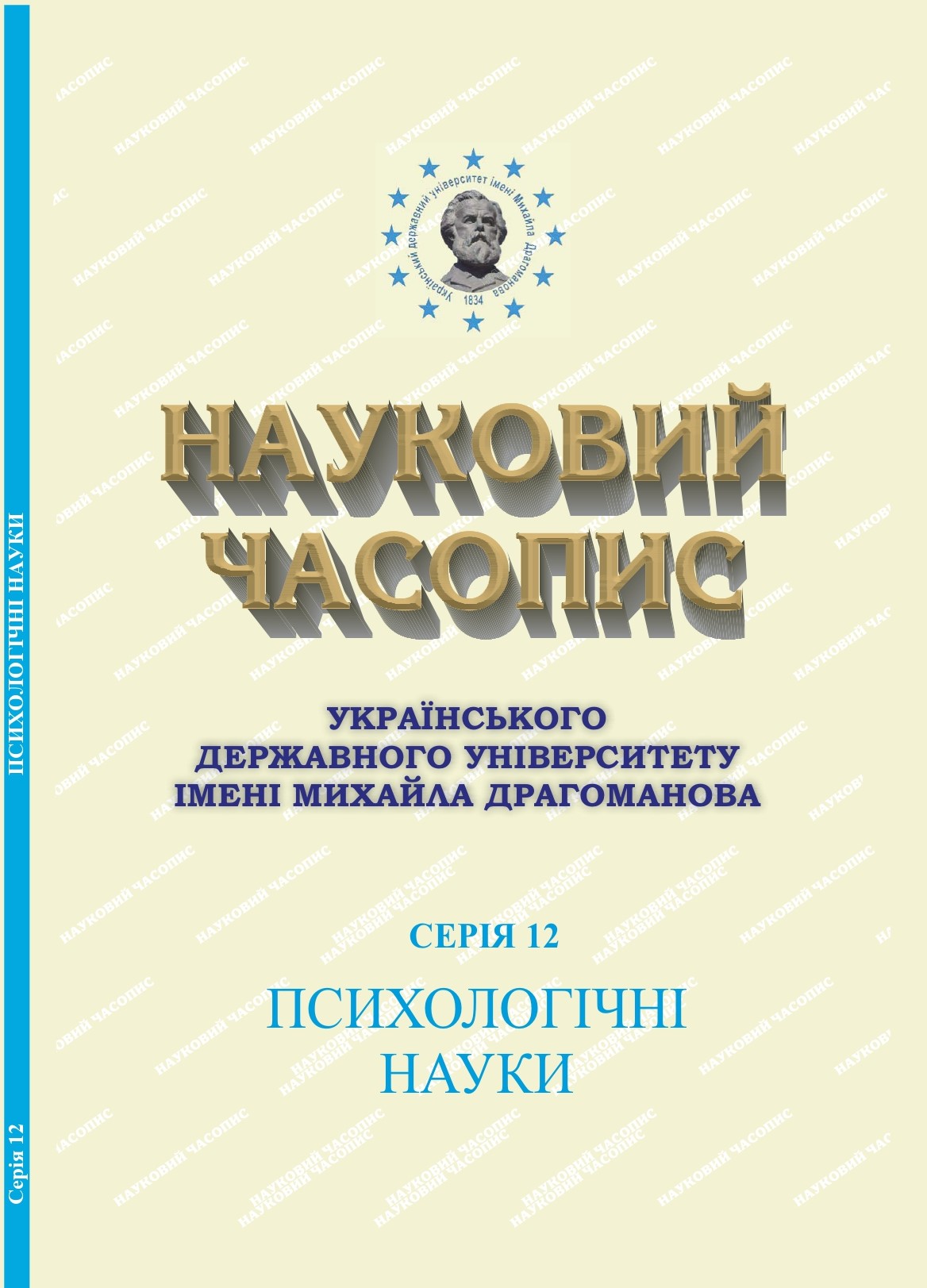SEMANTIC ILLOGICALITY IN THE PROCESS OF THINKING
DOI:
https://doi.org/10.31392/UDU-nc.series12.2023.22(67).06Keywords:
thinking, meaning, illogicality, contradiction, formal logic.Abstract
Objective. The article is aimed at establishing an empirical connection between semantic illogicality and other properties of thinking. Illogicality is defined as the semantic opposite of judgments, which is objectified in contradictory theses that cannot be true at the same time. The author assumes that illogic is one of the lower levels of thinking and is actualized in the case of an individual’s inability to rise to the operationalization of cognitive material using the laws of formal logic. Research methods: theoretical (analysis of procedural characteristics of thinking); empirical (“Method of textual gaps”); mathematical statistics (arithmetic mean, standard deviation, coefficient of variation, oscillation coefficient, correlation coefficient, linear regression analysis). The results. Mathematical and statistical analysis of the empirical material showed that the use of illogical formulations in the construction of meaning is typical for more than half of the researched. At the same time, the number of such formulations is insignificant and fluctuates quite strongly, so that it is possible to establish the regularity of their appearance. It is characteristic that the number of illogical formulations increases during the execution of the task. Illogical judgments are moderately inversely related to logical judgments. The phenomenon of illogic lowers the overall level of meaning formation, but this tendency is not pronounced. Conclusions. Semantic illogicality is an attempt to direct the narrative, to reveal cognitive subjectivity in a situation where the judgment can be formed only on the principle of opposition to the existing thesis. Illogicality plays a tactical role in the formation of general meaning and is revealed when constructive formal logical ways of unfolding the discourse become unavailable. Due to the production of illogicality, the subject ignores the meaning that is poorly crystallized for him/her and moves on to the crystallization of the original meaning. This is a tactical "mistake" on the way to the correct answer. Prospects for further research are to determine the links between illogic and other types of judgments that are conceptual for the formation of the general meaning and to compare manifestations of illogicality in different periods of ontogenesis.
References
- Karpenko, V.V. (2013). Psykholohiia myslennia: fenomenolohiia, protses i determinanty [Psychology of thinking: phenomenology, process and determinants]. Naukovyi visnyk Lvivskoho derzhavnoho universytetu vnutrishnikh sprav – Scientific Bulletin of the Lviv State University of Internal Affairs, 1, 32–42 [in Ukrainian]. Retrieved from https://dspace.lvduvs.edu.ua/handle/1234567890/1254 .
- Maziar, O.V. (2019). Absurdnist yak fundamentalna vlastyvist spryimannia [Absurdity as a fundamental property of perception]. Naukovyi visnyk Khersonskoho derzhavnoho universytetu. Zbirnyk naukovykh prats. Seriia «Psykholohichni nauky» – Scientific Bulletin of Kherson State University. Series «Psychological Sciences», 3, 30–36 [in Ukrainian]. https://doi.org/10.32999/KSU2312-3206 .
- Maziar, O.V. (2020). Osobystisnyj dysonans: systemnyj analiz [Personal dissonance: a systemic analysis]. Zhytomyr : Vydavec O.O. Jevenok [in Ukrainian]. Retrieved from http://eprints.zu.edu.ua/id/eprint/31583 .
- Superechnosti zakon [The law of contradiction] (2002). In I. Shynkaruk (Red.). Filosofskyi entsyklopedychnyi slovnyk – Philosophical encyclopedic dictionary. Kyiv : Instytut filosofii imeni Hryhoriia Skovorody NAN Ukrainy : Abrys [in Ukrainian]. Retrieved from https://archive.org/details/filosofskyi_entsyklop/page/260/mode/2up .
- Iatsenko, T., Halushko, L., Yevtushenko, I., & Manzhara, S. (2020). Pralohichnist myslennia psykholohav konteksti hlybynno-korektsiinoho piznannia [Pre-logical thinking of psychologists in the context of deep-corrective cognition]. Psykholohiia i suspilstvo – Psychology & society, 4(82), 54–69 [in Ukrainian]. https://doi.org/10.35774/pis04 .
- Acar, S., & Runco, M.A. (2019). Divergent thinking: New methods, recent research, and extended theory. Psychology of Aesthetics, Creativity, and the Arts, 13(2), 153–158. https://doi.org/10.1037/aca0000231 .
- Andrews-Hanna, J.R., Woo, C.-W., Wilcox, R., Eisenbarth, H., Kim, B., Han, J., Losin, E.A.R., & Wager, T.D. (2022). The conceptual building blocks of everyday thought: Tracking the emergence and dynamics of ruminative and nonruminative thinking. Journal of Experimental Psychology: General, 151(3), 628–642. https://doi.org/10.1037/xge0001096 .
- Beauvais, C., Pfeiffer, N., Habib, M., & Beauvais, L. (2020). Effect of the emotional valence of texts on their understanding and learning new words in grade 5 primary students. Canadian Journal of Experimental Psychology, 74(2), 144–155. https://doi.org/10.1037/cep0000194 .
- Dumas, D., Organisciak, P., & Doherty, M. (2021). Measuring divergent thinking originality with human raters and text-mining models: A psychometric comparison of methods. Psychology of Aesthetics, Creativity, and the Arts, 15(4), 645–663. https://doi.org/10.1037/aca0000319 .
- Kao,-Y. (2023, Jan. 2). Examining the attribute inheritance in Janusian thinking: An intensional study on the mechanisms of combining opposite concepts. Psychology of Aesthetics, Creativity, and the Arts. https://doi.org/10.1037/aca0000552 .
- Lin, Y., Zhang, Y.C., & Oyserman, D. (2022). Seeing meaning even when none may exist: Collectivism increases belief in empty claims. Journal of Personality and Social Psychology, 122(3), 351–366. https://doi.org/10.1037/pspa0000280 .
- Maciejewski, G., & Klepousniotou, E. (2020). Disambiguating the ambiguity disadvantage effect: Behavioral and electrophysiological evidence for semantic competition. Journal of Experimental Psychology: Learning, Memory, and Cognition, 46(9), 1682–1700. https://doi.org/10.1037/xlm0000842 .
- Paquet, C., Cogan, C.M., & Davis, J.L. (2020). A quantitative text analysis approach to describing posttrauma nightmares in a treatment-seeking population. Dreaming, 30(1), 54–67. https://doi.org/10.1037/drm0000128 .
- Petroviс, M.B., Žeželj, I. (2022). Thinking inconsistently: Development and validation of an instrument for assessing proneness to doublethink. European Journal of Psychological Assessment, 38(6), 463–475. https://doi.org/10.1027/1015-5759/a000645 .
- Priester, J., Petty, R., & Park, K. (2007). Whence Univalent Ambivalence? From the Anticipation of Conflicting Reactions. Journal of Consumer Research, 34(1), 11–21. https://doi.org/1086/513042 .
- Song, H., & Ewoldsen, D. (2015). Metacognitive Model of Ambivalence: The Role of Multiple Beliefs and Metacognitions in Creating Attitude Ambivalence. Communication Theory, 25(1), 23–45. https://doi.org/10.1111/comt.12050 .
- Taylor, L.D., & Acic, I. (2021). Magical thinking and fans of fictional texts. Psychology of Popular Media, 10(1), 21–27. https://doi.org/10.1037/ppm0000279
- Vrana, S.R., Bono, R.S., Konig, A., & Scalzo, G.C. (2019). Assessing the coherence of narratives of traumatic events with latent semantic analysis. Psychological Trauma: Theory, Research, Practice, and Policy, 11(5), 521–524. https://doi.org/10.1037/tra0000415

